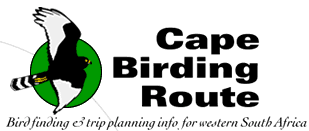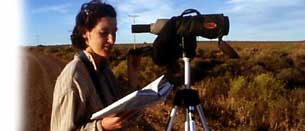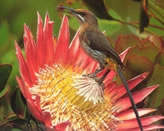Kirstenbosch
National Botanical Garden
Widely recognized as one of the world’s finest botanical
gardens, Kirstenbosch would be an essential destination for
its pleasing landscapes and spectacular floral displays alone.
Additionally, the well-maintained gardens and adjacent fynbos
and indigenous forest support an attractive diversity of bird
species. Here, it is possible to approach a number of Cape endemics
at close quarters, including such desirable species as Cape
Sugarbird (p.33*), Orange-breasted
Sunbird (p.33*) and Cape Francolin.
The
modern Visitors’ Centre (1 on site map overleaf), located
near the main entrance, is well worth exploring. Here one
can enjoy a meal, browse the well-stocked tourist shop, consult
the information kiosk, or search the excellent bookshop —
offering arguably Cape Town’s best selection of natural
history titles. The Visitors’ Centre is also home to
a world-class glasshouse (the Conservatory), which contains
a variety of succulent plants from South Africa’s arid
areas. Ranging from a huge baobab to tiny stone-plants, this
fascinating display is highly recommended for those with even
the most casual botanical interest. A pair of Spotted Eagle
Owls nests annually in the camphor trees just behind the
Visitors’ Centre, and the staff usually know their precise
whereabouts.
Castle
Buttress stands sentinel above the gardens, flanked by Skeleton
Gorge and Nursery Ravine. These are two of the numerous gorges
that cut through the steep and moist eastern face of Table
Mountain, providing welcome refuge from the often baking summer
heat of the surrounding fynbos. In the ravines, two metres
of annual rainfall maintains pockets of pristine afromontane
forest, through which acidic, fast-flowing streams course
over moss-swathed boulders and decaying trunks festooned with
ferns. Clinging, well-concealed, to the shaggy moss of these
streams is the very rare Table Mountain Ghost Frog (Heleophryne
rosei), which is globally restricted to just a handful
of gorges on these eastern slopes. Despite the idyllic setting,
however, birders may find the Peninsula’s forests disappointingly
quiet relative to the diversity that abounds farther east
— although there are rewards for those who are patient.
The
most accessible forest is along the Braille Trail (2 on map
opposite) an easy walk that loops gently through the trees.
It begins on a broad gravel path opposite the Fragrance Garden,
which is just a short stroll across the lower lawns from the
main entrance and Visitors’ Centre. It is best to start
here as early as possible, as human activity increases steadily
during the morning. Knysna
Warbler (p.32*) sometimes lurks along the streams
and thickets here, but the Constantia Greenbelts (p.18) and
Skeleton Gorge (p.19) are more reliable places to search for
it. Cinnamon Dove is a true forest species that is
often found shuffling through the leaf litter in the dappled
shade of the understorey. For the best chance of seeing it,
make an early start up the gravel track mentioned above (2),
concentrating your search at the sharp corner after about
300 m (3). Other forest birds found here and along the Braille
Trail also extend down into the formal gardens. These include
Rameron Pigeon, Sombre Bulbul, Olive Thrush
(p.13), Cape Batis, Paradise and Dusky Flycatchers,
and Forest Canary — the latter a relatively recent
arrival on the Peninsula (see
page on recent arrivals on the Peninsula). The whole of
Kirstenbosch is also a fine area for raptors: early mornings
and evenings are when forest hawks, such as Red-breasted
and Black Sparrowhawks and African Goshawk,
are most likely to be seen (see box, p.18).
Next,
visit the small, tranquil forest patch, known as the Dell,
which surrounds Colonel Bird’s Bath, a clear spring welling
up in the middle of the gardens (4). The huge trees overlooking
the spring invariably hold perched Rameron Pigeons.
From the Dell, one can ascend through the jumble of the Cycad
Garden into the upper part of Kirstenbosch (5), where protea
and erica plants abound. Their flowerheads are adorned with
Cape
Sugarbirds and Orange-breasted
Sunbirds respectively, whose approachability will
be much appreciated by photographers. Fynbos vegetation is
globally renowned for its remarkable diversity of bird-pollinated
plant species, and Kirstenbosch is a perfect place to observe
this mutualism in action.
Make
your way downhill from the protea section, along the right
hand edge of the Dell, following one of the myriad paths that
eventually lead to the lower gardens. Common and conspicuous
birds of the cultivated gardens are Cape Francolin,
Helmeted Guineafowl, Cape Robin, Karoo Prinia,
Southern Boubou and Lesser Double-collared Sunbird.
Species found here that are characteristic of more wooded
environments in the Cape are Red-chested Cuckoo (calling
September— November), Black Saw-wing Swallow (summer),
Speckled Mousebird and Bully Canary. Passing
the Aloe Garden (6), look carefully at Kirstenbosch’s
unusual Fiscal Shrikes, which show a patchy white eyebrow,
characteristic of the northern Cape subspecies. Before leaving,
it is worth visiting the small marsh (7) that lies below the
old parking area. Here, the noisy Grassbird, Levaillant’s
Cisticola and Common Waxbill vie with the ceaseless
chorus of Cape Chirping Frogs (Arthroleptella lightfooti)
and Clicking Stream Frogs (Strongylopus grayii).
The
forests high above Kirstenbosch are the haunt of the localized
and reclusive Knysna
Warbler (p.32*), a southern Cape endemic which lurks
in the forest understorey, giving a beautiful song but obstinately
resisting attempts at a clear view. Birders who enjoy hiking
and decide to venture up to the top of Skeleton Gorge in search
of Knysna
Warbler might consider a round trip, returning behind
Castle Buttress and down Nursery Ravine. This moderately strenuous
half-day walk along orchid-lined streams quickly elevates
one from the hustle and bustle of the city suburbs below and
into the calm sanctum of Table Mountain’s southern reaches.
Although Knysna
Warbler occurs along the length of the Skeleton stream,
it is perhaps most easily seen in the bracken-dominated section
at the head of the gorge, where the path climbs out of the
rocky riverbed. On the mountain top, a pair of Black Eagles
regularly hunts, Black Swifts nest in the cliffs at
the top of Nursery Ravine, and Cape
Siskin (p.33*) and Ground
Woodpecker (p.105*) occur on the rocky crags of the
buttress proper. The unrivalled elusiveness of the Striped
Flufftail will become immediately apparent to anyone following
up the bizarre cackles and hoots that emanate from the denser
fynbos.
|


